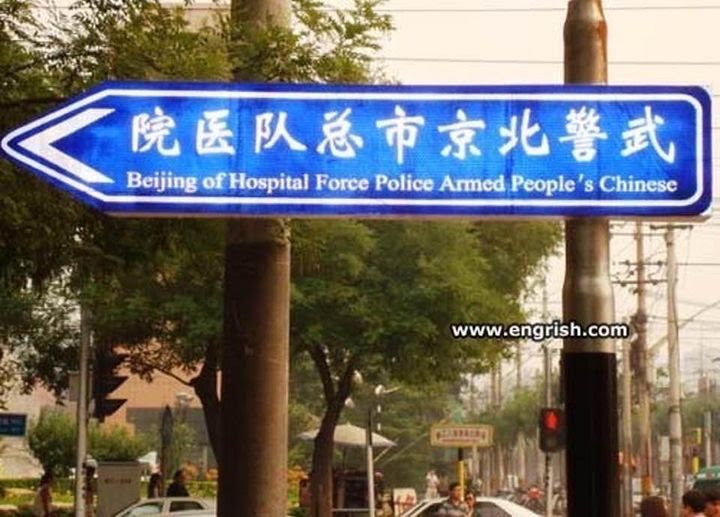Right to left
« previous post | next post »
From John Rohsenow:
In normal orientation, left to right, the sign reads:
Wǔjǐng běijīng shì zǒngduì yīyuàn
武警北京市总队医院
Beijing Armed Police Corps Hospital
Maybe they were inspired to write it this way because it was a left turn sign.
Selected readings
- "Backward characters" (9/7/17)
- "Massachusetts is red(-faced)" (6/5/09)
- "Hooked on pot" (7/9/13)
- "Left to right or right to left?" (2/3/19)
[Thanks to John Rohsenow]

Mark Hansell said,
July 17, 2022 @ 8:50 pm
I've seen many vehicles in China where the order of writing on the side was always front-to-back: left-to-right on the driver's side, right-to-left on the passenger's side. Chinese written this way was pretty easy to understand, but sometimes there would be Pinyin (usually without word breaks), which was totally incomprehensible.
Cynthia Yumei Ning said,
July 17, 2022 @ 9:41 pm
Somewhere among my photos I have pictures of three signs (characters only) placed next to each other, say in a railway station, where sign A is written right-to-left (say, 津天往), sign B is written top-to-bottom (say, 往
北
, and sign C is written left-to-right. All perfectly comprehensible!
Cynthia Yumei Ning said,
July 17, 2022 @ 9:44 pm
Shoots. That comment posted before I was done writing it. The middle sign would have been something like 往北京 and sign C something like 往成都。
Philip Schnell said,
July 17, 2022 @ 9:45 pm
That’s common practice on boats and ferries in Japan as well: left-to-right on the port side, right-to-left on starboard. I remember being mightily puzzled when I was first learning the language by my local ferry Sekizen being labeled んぜきせ (N-ZE-KI-SE).
But by far the weirdest example I’ve seen was a shipping company known as Osaki that adopted that rule for their trucks but wrote the name in rо̄maji, so that the left side said “OSAKI,” while the right side said “IKASO.”
Theo said,
July 18, 2022 @ 2:32 pm
While this may well be due to the directionality of the sign, right-to-left horizontal script isn't at all uncommon outside of Mainland China.
See: https://en.m.wikipedia.org/wiki/Horizontal_and_vertical_writing_in_East_Asian_scripts
More pictures: https://zh.m.wikipedia.org/wiki/%E7%B8%B1%E6%9B%B8%E8%88%87%E6%A9%AB%E6%9B%B8
Neil Kubler said,
July 18, 2022 @ 5:06 pm
I have a cap given to me at one of Taiwan's national parks where on the left-hand side of the cap it says (written from LEFT TO RIGHT, aiming toward the FRONT of the cap) 替世世代代創造玫麗的明天 "for each generation create a tomorrow as beautiful as a rose"; and on the right-hand side of the cap it says (written from RIGHT TO LEFT, again aiming toward the FRONT of the cap) 土樂的好美下留孫孫子子為 "for all the generations leave behind a wonderful paradise". Similarly, a store in Shanghai I once visited had two signs, each moving from the FRONT of the store toward the BACK of the store, one written on the LEFT side of the front entrance, from right to left, as 明文神精设建 "construct a spiritual civilization" and another on the right side of the store, again moving away from the front of the store, written from left to right, as 发扬道德新风 "develop a new style of morality". And then, of course, if we're in the library looking for a certain book title, Chinese titles typically are printed top to bottom, so we don't need to turn our heads and crane our necks as when searching for Roman alphabet titles. While Chinese characters certainly have their disadvantages, this flexibility of the Chinese writing system must be counted among its advantages.
Andrew G Stow said,
July 19, 2022 @ 10:34 am
I have a photo I took of the right side of a bus in Wuxi. It says:
. OC TROSNART REGNESSAP GNOHIAH IXUW
Took me a few seconds.
David Morris said,
July 20, 2022 @ 3:28 pm
A shop door in South Korea had EMOC on the left door handle and LEW on the right. It took me more than a moment to figure out. I'm sure that was a mistake.